Inclusion: Analysis of Stakeholders, Policies, and Impacts
VerifiedAdded on 2023/06/08
|9
|1918
|71
Report
AI Summary
This report provides a comprehensive analysis of inclusion in early childhood education, examining various perspectives and impacts. It begins with an introduction to the concept of inclusion, highlighting its significance for children with disabilities and developmental delays. The report identifies key stakeholders, including early childhood educators, practitioners, and families, and explores the collaborative efforts aimed at promoting inclusion. It delves into the political perspective, discussing government policies, funding, and the challenges faced in implementing inclusive practices. The media's role in shaping perceptions of inclusion is also considered, with examples of media coverage and its influence on public awareness. The report further investigates the impact of inclusion on early childhood educators, examining policy reforms and the need for adequate training and support. The effects of inclusion on children and families are also explored, emphasizing the importance of specialized instruction, organizational support, and collaboration. The analysis draws upon multiple scholarly sources to support its findings, providing a well-rounded understanding of the complexities of inclusion and its implications for various stakeholders. The report concludes by emphasizing the critical role of families, communities, government, and early childhood practitioners in successfully implementing inclusive practices.

Running head: INCLUSION
Inclusion
The Name of the Student:
The Name of the University:
Author Note:
Inclusion
The Name of the Student:
The Name of the University:
Author Note:
Paraphrase This Document
Need a fresh take? Get an instant paraphrase of this document with our AI Paraphraser
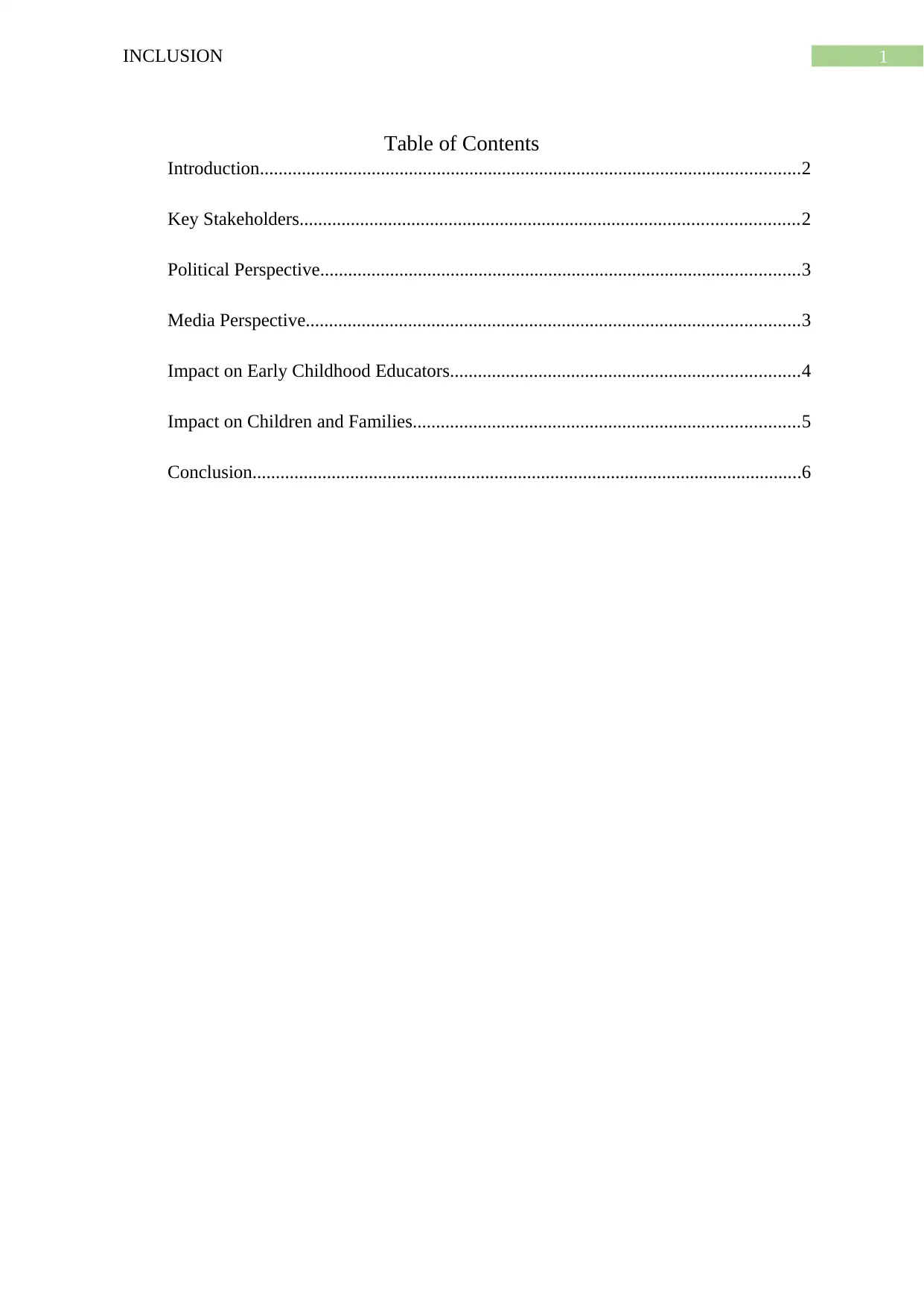
1INCLUSION
Table of Contents
Introduction....................................................................................................................2
Key Stakeholders...........................................................................................................2
Political Perspective.......................................................................................................3
Media Perspective..........................................................................................................3
Impact on Early Childhood Educators...........................................................................4
Impact on Children and Families...................................................................................5
Conclusion......................................................................................................................6
Table of Contents
Introduction....................................................................................................................2
Key Stakeholders...........................................................................................................2
Political Perspective.......................................................................................................3
Media Perspective..........................................................................................................3
Impact on Early Childhood Educators...........................................................................4
Impact on Children and Families...................................................................................5
Conclusion......................................................................................................................6
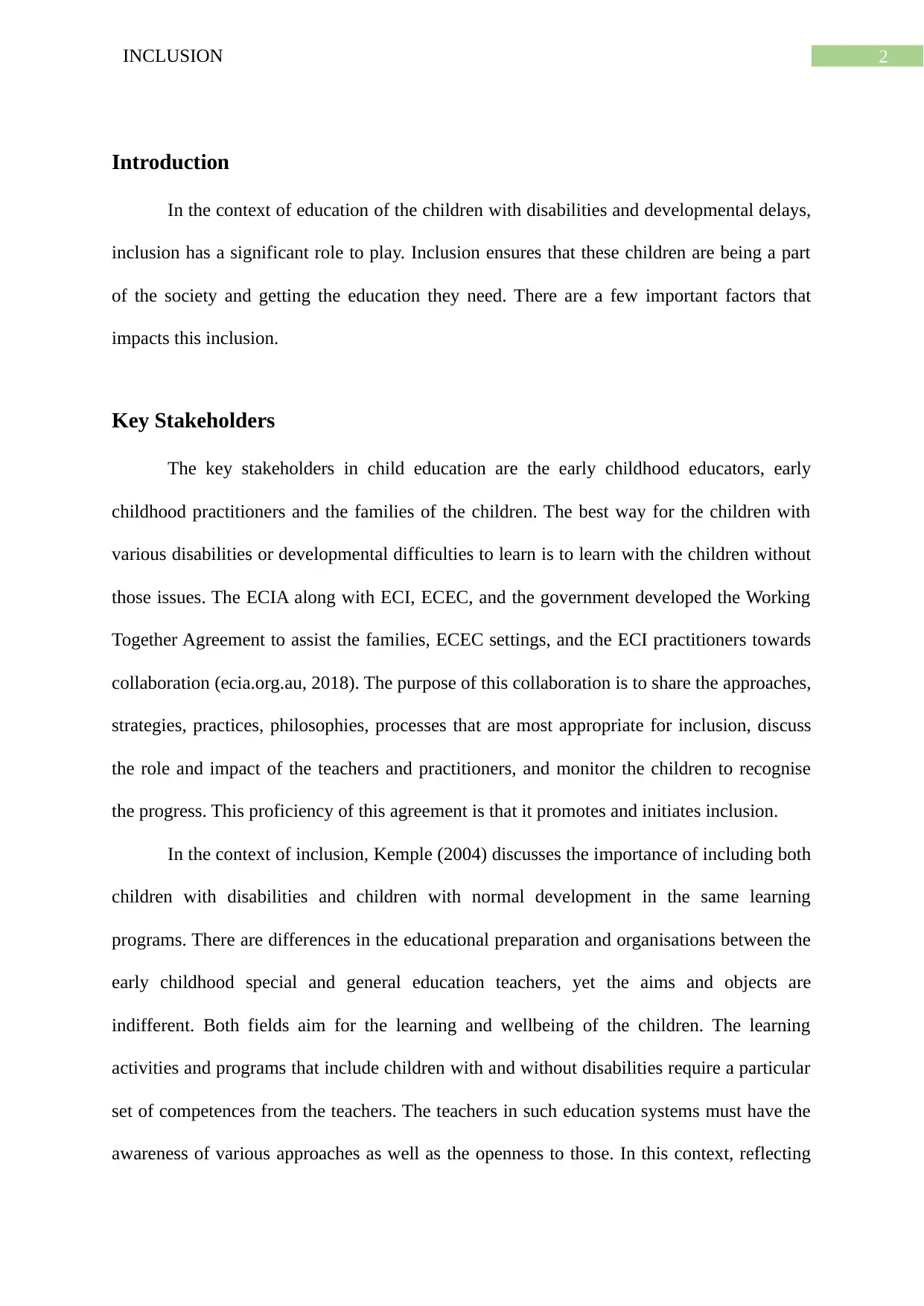
2INCLUSION
Introduction
In the context of education of the children with disabilities and developmental delays,
inclusion has a significant role to play. Inclusion ensures that these children are being a part
of the society and getting the education they need. There are a few important factors that
impacts this inclusion.
Key Stakeholders
The key stakeholders in child education are the early childhood educators, early
childhood practitioners and the families of the children. The best way for the children with
various disabilities or developmental difficulties to learn is to learn with the children without
those issues. The ECIA along with ECI, ECEC, and the government developed the Working
Together Agreement to assist the families, ECEC settings, and the ECI practitioners towards
collaboration (ecia.org.au, 2018). The purpose of this collaboration is to share the approaches,
strategies, practices, philosophies, processes that are most appropriate for inclusion, discuss
the role and impact of the teachers and practitioners, and monitor the children to recognise
the progress. This proficiency of this agreement is that it promotes and initiates inclusion.
In the context of inclusion, Kemple (2004) discusses the importance of including both
children with disabilities and children with normal development in the same learning
programs. There are differences in the educational preparation and organisations between the
early childhood special and general education teachers, yet the aims and objects are
indifferent. Both fields aim for the learning and wellbeing of the children. The learning
activities and programs that include children with and without disabilities require a particular
set of competences from the teachers. The teachers in such education systems must have the
awareness of various approaches as well as the openness to those. In this context, reflecting
Introduction
In the context of education of the children with disabilities and developmental delays,
inclusion has a significant role to play. Inclusion ensures that these children are being a part
of the society and getting the education they need. There are a few important factors that
impacts this inclusion.
Key Stakeholders
The key stakeholders in child education are the early childhood educators, early
childhood practitioners and the families of the children. The best way for the children with
various disabilities or developmental difficulties to learn is to learn with the children without
those issues. The ECIA along with ECI, ECEC, and the government developed the Working
Together Agreement to assist the families, ECEC settings, and the ECI practitioners towards
collaboration (ecia.org.au, 2018). The purpose of this collaboration is to share the approaches,
strategies, practices, philosophies, processes that are most appropriate for inclusion, discuss
the role and impact of the teachers and practitioners, and monitor the children to recognise
the progress. This proficiency of this agreement is that it promotes and initiates inclusion.
In the context of inclusion, Kemple (2004) discusses the importance of including both
children with disabilities and children with normal development in the same learning
programs. There are differences in the educational preparation and organisations between the
early childhood special and general education teachers, yet the aims and objects are
indifferent. Both fields aim for the learning and wellbeing of the children. The learning
activities and programs that include children with and without disabilities require a particular
set of competences from the teachers. The teachers in such education systems must have the
awareness of various approaches as well as the openness to those. In this context, reflecting
⊘ This is a preview!⊘
Do you want full access?
Subscribe today to unlock all pages.

Trusted by 1+ million students worldwide
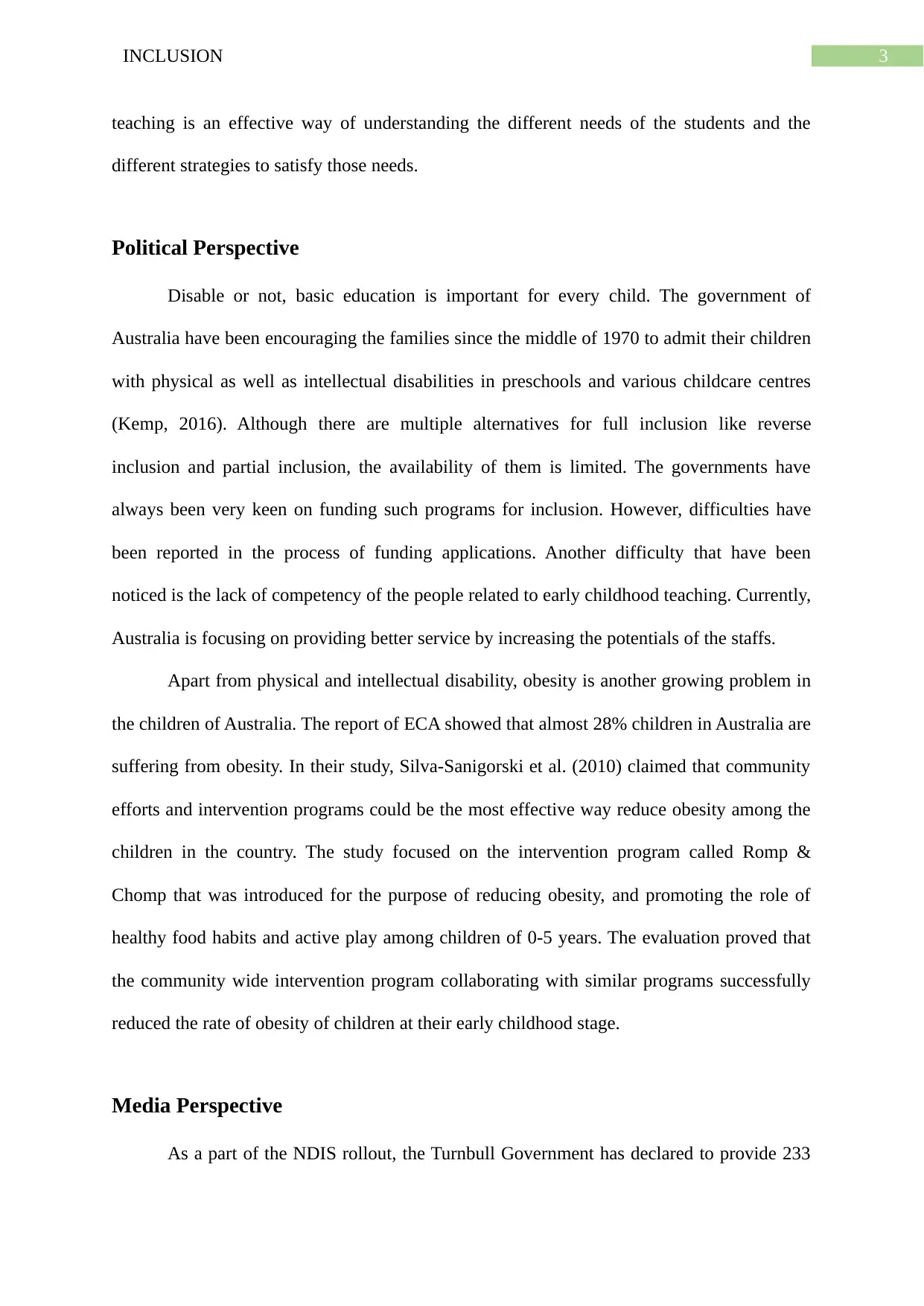
3INCLUSION
teaching is an effective way of understanding the different needs of the students and the
different strategies to satisfy those needs.
Political Perspective
Disable or not, basic education is important for every child. The government of
Australia have been encouraging the families since the middle of 1970 to admit their children
with physical as well as intellectual disabilities in preschools and various childcare centres
(Kemp, 2016). Although there are multiple alternatives for full inclusion like reverse
inclusion and partial inclusion, the availability of them is limited. The governments have
always been very keen on funding such programs for inclusion. However, difficulties have
been reported in the process of funding applications. Another difficulty that have been
noticed is the lack of competency of the people related to early childhood teaching. Currently,
Australia is focusing on providing better service by increasing the potentials of the staffs.
Apart from physical and intellectual disability, obesity is another growing problem in
the children of Australia. The report of ECA showed that almost 28% children in Australia are
suffering from obesity. In their study, Silva-Sanigorski et al. (2010) claimed that community
efforts and intervention programs could be the most effective way reduce obesity among the
children in the country. The study focused on the intervention program called Romp &
Chomp that was introduced for the purpose of reducing obesity, and promoting the role of
healthy food habits and active play among children of 0-5 years. The evaluation proved that
the community wide intervention program collaborating with similar programs successfully
reduced the rate of obesity of children at their early childhood stage.
Media Perspective
As a part of the NDIS rollout, the Turnbull Government has declared to provide 233
teaching is an effective way of understanding the different needs of the students and the
different strategies to satisfy those needs.
Political Perspective
Disable or not, basic education is important for every child. The government of
Australia have been encouraging the families since the middle of 1970 to admit their children
with physical as well as intellectual disabilities in preschools and various childcare centres
(Kemp, 2016). Although there are multiple alternatives for full inclusion like reverse
inclusion and partial inclusion, the availability of them is limited. The governments have
always been very keen on funding such programs for inclusion. However, difficulties have
been reported in the process of funding applications. Another difficulty that have been
noticed is the lack of competency of the people related to early childhood teaching. Currently,
Australia is focusing on providing better service by increasing the potentials of the staffs.
Apart from physical and intellectual disability, obesity is another growing problem in
the children of Australia. The report of ECA showed that almost 28% children in Australia are
suffering from obesity. In their study, Silva-Sanigorski et al. (2010) claimed that community
efforts and intervention programs could be the most effective way reduce obesity among the
children in the country. The study focused on the intervention program called Romp &
Chomp that was introduced for the purpose of reducing obesity, and promoting the role of
healthy food habits and active play among children of 0-5 years. The evaluation proved that
the community wide intervention program collaborating with similar programs successfully
reduced the rate of obesity of children at their early childhood stage.
Media Perspective
As a part of the NDIS rollout, the Turnbull Government has declared to provide 233
Paraphrase This Document
Need a fresh take? Get an instant paraphrase of this document with our AI Paraphraser
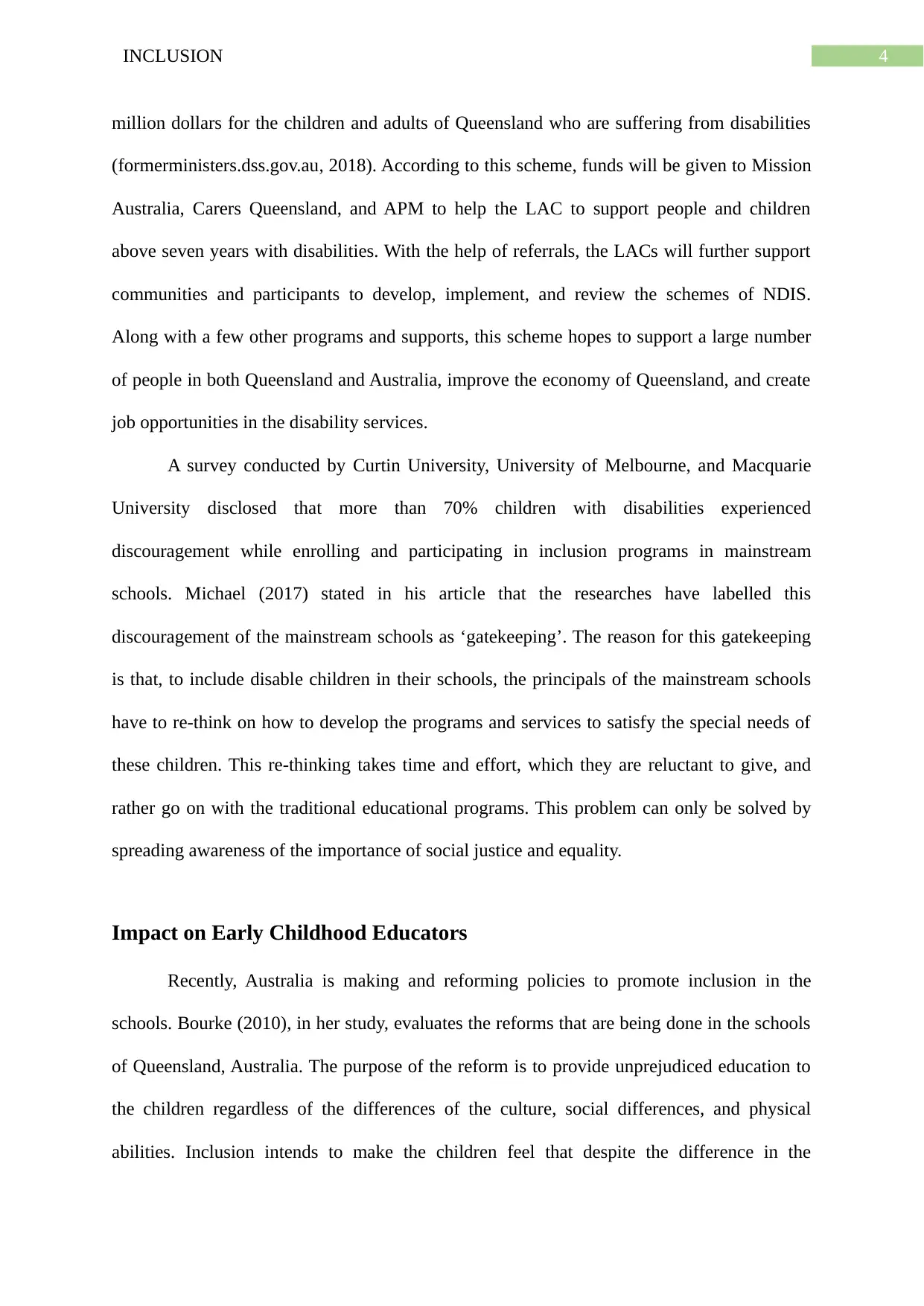
4INCLUSION
million dollars for the children and adults of Queensland who are suffering from disabilities
(formerministers.dss.gov.au, 2018). According to this scheme, funds will be given to Mission
Australia, Carers Queensland, and APM to help the LAC to support people and children
above seven years with disabilities. With the help of referrals, the LACs will further support
communities and participants to develop, implement, and review the schemes of NDIS.
Along with a few other programs and supports, this scheme hopes to support a large number
of people in both Queensland and Australia, improve the economy of Queensland, and create
job opportunities in the disability services.
A survey conducted by Curtin University, University of Melbourne, and Macquarie
University disclosed that more than 70% children with disabilities experienced
discouragement while enrolling and participating in inclusion programs in mainstream
schools. Michael (2017) stated in his article that the researches have labelled this
discouragement of the mainstream schools as ‘gatekeeping’. The reason for this gatekeeping
is that, to include disable children in their schools, the principals of the mainstream schools
have to re-think on how to develop the programs and services to satisfy the special needs of
these children. This re-thinking takes time and effort, which they are reluctant to give, and
rather go on with the traditional educational programs. This problem can only be solved by
spreading awareness of the importance of social justice and equality.
Impact on Early Childhood Educators
Recently, Australia is making and reforming policies to promote inclusion in the
schools. Bourke (2010), in her study, evaluates the reforms that are being done in the schools
of Queensland, Australia. The purpose of the reform is to provide unprejudiced education to
the children regardless of the differences of the culture, social differences, and physical
abilities. Inclusion intends to make the children feel that despite the difference in the
million dollars for the children and adults of Queensland who are suffering from disabilities
(formerministers.dss.gov.au, 2018). According to this scheme, funds will be given to Mission
Australia, Carers Queensland, and APM to help the LAC to support people and children
above seven years with disabilities. With the help of referrals, the LACs will further support
communities and participants to develop, implement, and review the schemes of NDIS.
Along with a few other programs and supports, this scheme hopes to support a large number
of people in both Queensland and Australia, improve the economy of Queensland, and create
job opportunities in the disability services.
A survey conducted by Curtin University, University of Melbourne, and Macquarie
University disclosed that more than 70% children with disabilities experienced
discouragement while enrolling and participating in inclusion programs in mainstream
schools. Michael (2017) stated in his article that the researches have labelled this
discouragement of the mainstream schools as ‘gatekeeping’. The reason for this gatekeeping
is that, to include disable children in their schools, the principals of the mainstream schools
have to re-think on how to develop the programs and services to satisfy the special needs of
these children. This re-thinking takes time and effort, which they are reluctant to give, and
rather go on with the traditional educational programs. This problem can only be solved by
spreading awareness of the importance of social justice and equality.
Impact on Early Childhood Educators
Recently, Australia is making and reforming policies to promote inclusion in the
schools. Bourke (2010), in her study, evaluates the reforms that are being done in the schools
of Queensland, Australia. The purpose of the reform is to provide unprejudiced education to
the children regardless of the differences of the culture, social differences, and physical
abilities. Inclusion intends to make the children feel that despite the difference in the
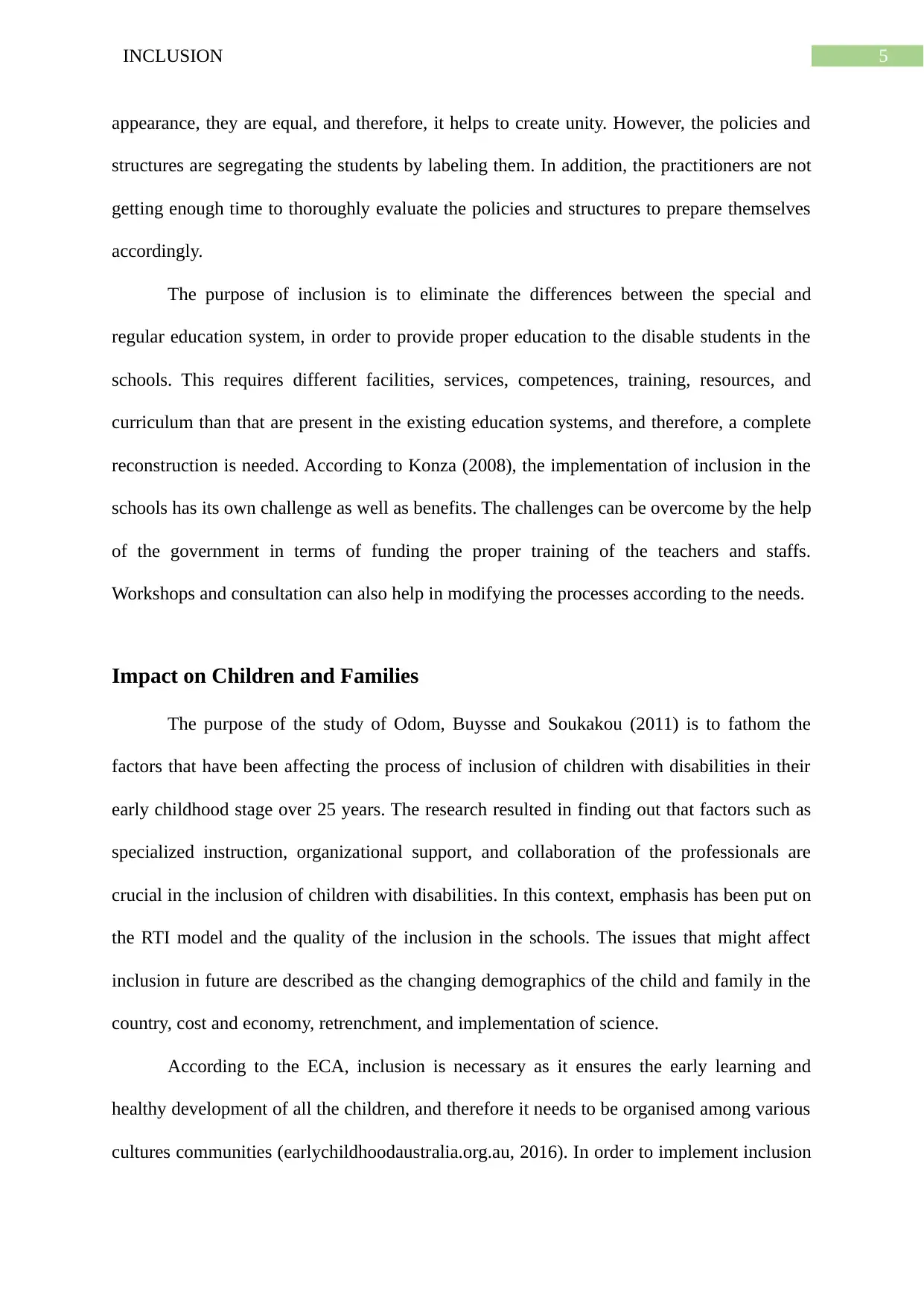
5INCLUSION
appearance, they are equal, and therefore, it helps to create unity. However, the policies and
structures are segregating the students by labeling them. In addition, the practitioners are not
getting enough time to thoroughly evaluate the policies and structures to prepare themselves
accordingly.
The purpose of inclusion is to eliminate the differences between the special and
regular education system, in order to provide proper education to the disable students in the
schools. This requires different facilities, services, competences, training, resources, and
curriculum than that are present in the existing education systems, and therefore, a complete
reconstruction is needed. According to Konza (2008), the implementation of inclusion in the
schools has its own challenge as well as benefits. The challenges can be overcome by the help
of the government in terms of funding the proper training of the teachers and staffs.
Workshops and consultation can also help in modifying the processes according to the needs.
Impact on Children and Families
The purpose of the study of Odom, Buysse and Soukakou (2011) is to fathom the
factors that have been affecting the process of inclusion of children with disabilities in their
early childhood stage over 25 years. The research resulted in finding out that factors such as
specialized instruction, organizational support, and collaboration of the professionals are
crucial in the inclusion of children with disabilities. In this context, emphasis has been put on
the RTI model and the quality of the inclusion in the schools. The issues that might affect
inclusion in future are described as the changing demographics of the child and family in the
country, cost and economy, retrenchment, and implementation of science.
According to the ECA, inclusion is necessary as it ensures the early learning and
healthy development of all the children, and therefore it needs to be organised among various
cultures communities (earlychildhoodaustralia.org.au, 2016). In order to implement inclusion
appearance, they are equal, and therefore, it helps to create unity. However, the policies and
structures are segregating the students by labeling them. In addition, the practitioners are not
getting enough time to thoroughly evaluate the policies and structures to prepare themselves
accordingly.
The purpose of inclusion is to eliminate the differences between the special and
regular education system, in order to provide proper education to the disable students in the
schools. This requires different facilities, services, competences, training, resources, and
curriculum than that are present in the existing education systems, and therefore, a complete
reconstruction is needed. According to Konza (2008), the implementation of inclusion in the
schools has its own challenge as well as benefits. The challenges can be overcome by the help
of the government in terms of funding the proper training of the teachers and staffs.
Workshops and consultation can also help in modifying the processes according to the needs.
Impact on Children and Families
The purpose of the study of Odom, Buysse and Soukakou (2011) is to fathom the
factors that have been affecting the process of inclusion of children with disabilities in their
early childhood stage over 25 years. The research resulted in finding out that factors such as
specialized instruction, organizational support, and collaboration of the professionals are
crucial in the inclusion of children with disabilities. In this context, emphasis has been put on
the RTI model and the quality of the inclusion in the schools. The issues that might affect
inclusion in future are described as the changing demographics of the child and family in the
country, cost and economy, retrenchment, and implementation of science.
According to the ECA, inclusion is necessary as it ensures the early learning and
healthy development of all the children, and therefore it needs to be organised among various
cultures communities (earlychildhoodaustralia.org.au, 2016). In order to implement inclusion
⊘ This is a preview!⊘
Do you want full access?
Subscribe today to unlock all pages.

Trusted by 1+ million students worldwide
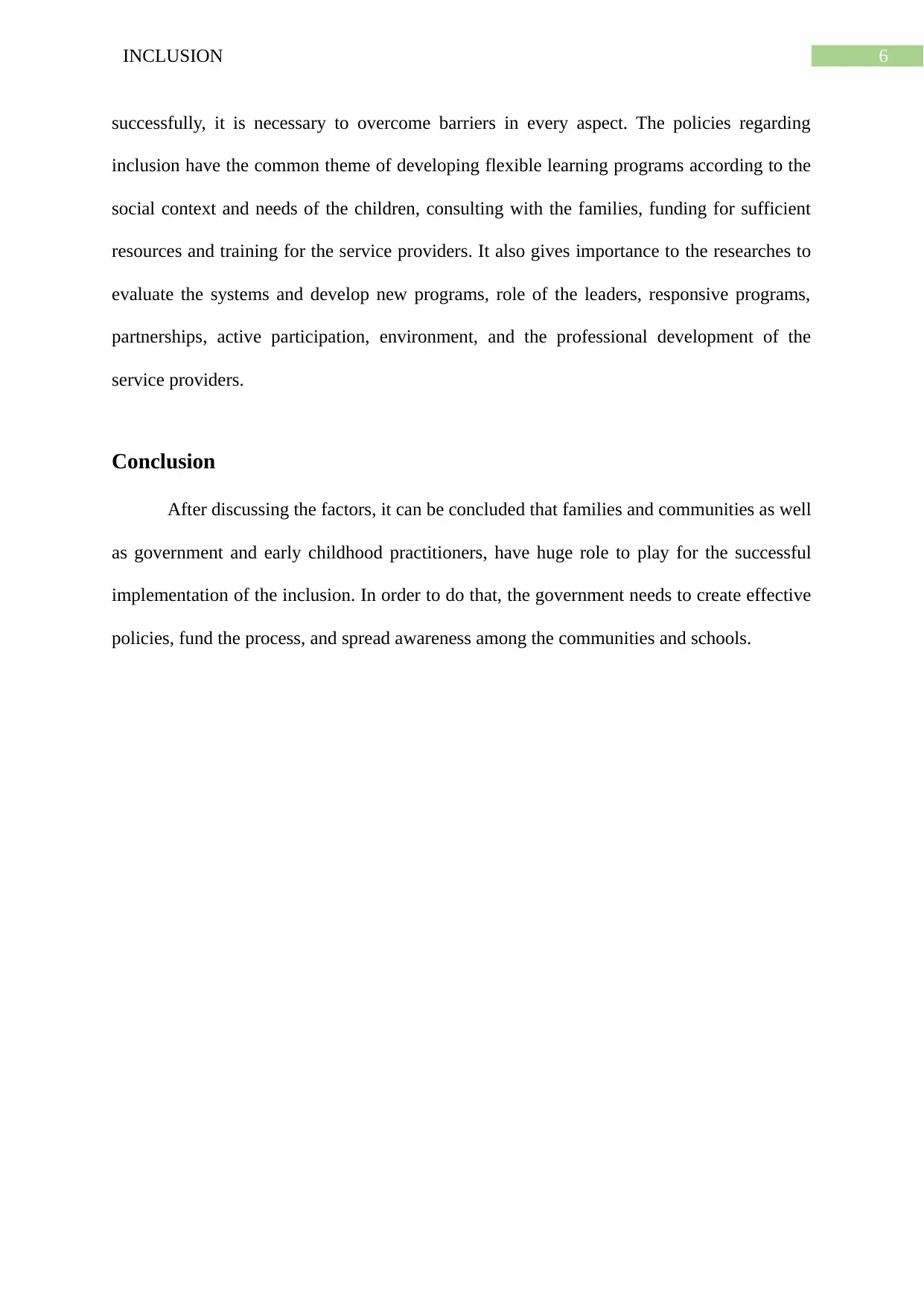
6INCLUSION
successfully, it is necessary to overcome barriers in every aspect. The policies regarding
inclusion have the common theme of developing flexible learning programs according to the
social context and needs of the children, consulting with the families, funding for sufficient
resources and training for the service providers. It also gives importance to the researches to
evaluate the systems and develop new programs, role of the leaders, responsive programs,
partnerships, active participation, environment, and the professional development of the
service providers.
Conclusion
After discussing the factors, it can be concluded that families and communities as well
as government and early childhood practitioners, have huge role to play for the successful
implementation of the inclusion. In order to do that, the government needs to create effective
policies, fund the process, and spread awareness among the communities and schools.
successfully, it is necessary to overcome barriers in every aspect. The policies regarding
inclusion have the common theme of developing flexible learning programs according to the
social context and needs of the children, consulting with the families, funding for sufficient
resources and training for the service providers. It also gives importance to the researches to
evaluate the systems and develop new programs, role of the leaders, responsive programs,
partnerships, active participation, environment, and the professional development of the
service providers.
Conclusion
After discussing the factors, it can be concluded that families and communities as well
as government and early childhood practitioners, have huge role to play for the successful
implementation of the inclusion. In order to do that, the government needs to create effective
policies, fund the process, and spread awareness among the communities and schools.
Paraphrase This Document
Need a fresh take? Get an instant paraphrase of this document with our AI Paraphraser
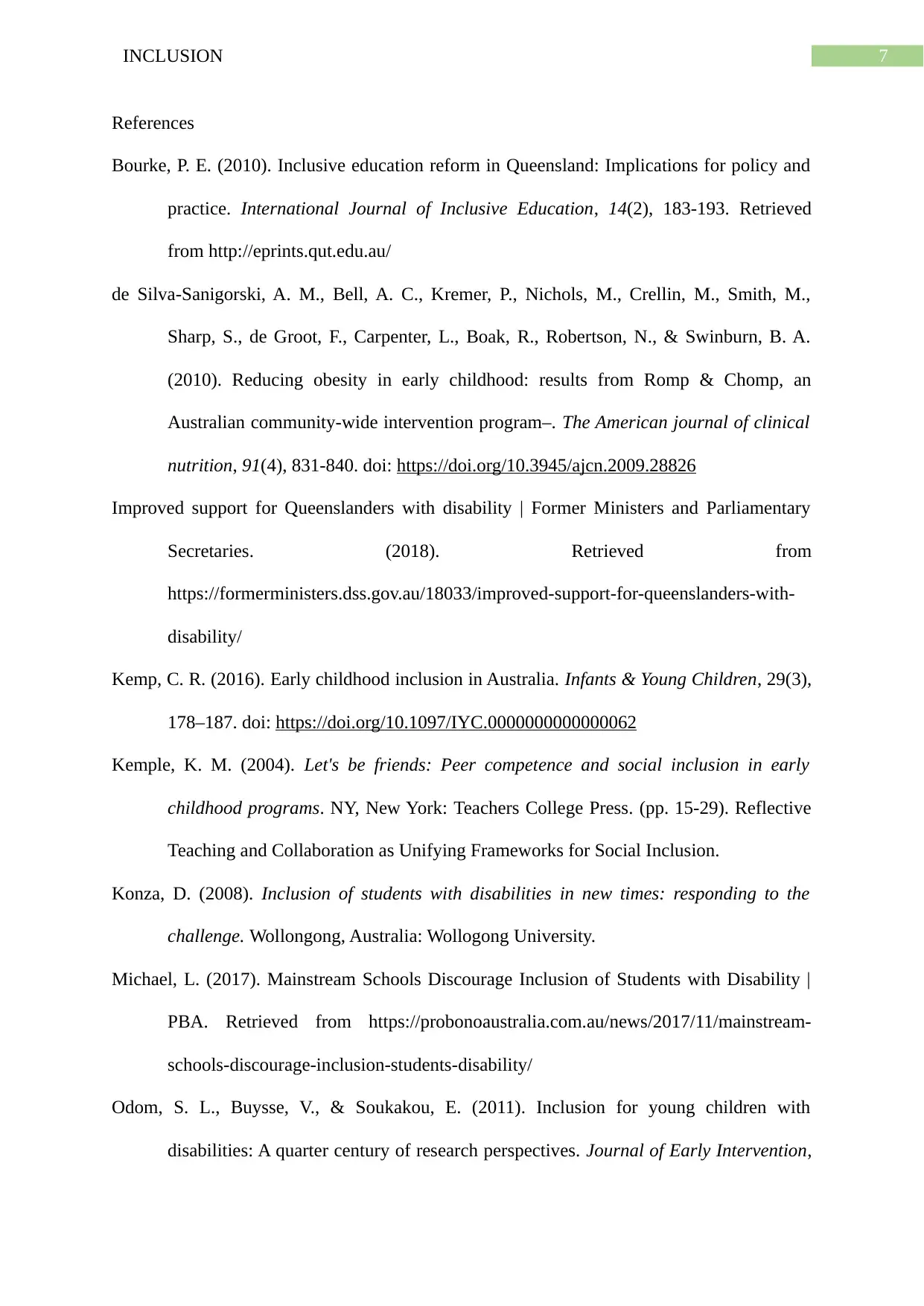
7INCLUSION
References
Bourke, P. E. (2010). Inclusive education reform in Queensland: Implications for policy and
practice. International Journal of Inclusive Education, 14(2), 183-193. Retrieved
from http://eprints.qut.edu.au/
de Silva-Sanigorski, A. M., Bell, A. C., Kremer, P., Nichols, M., Crellin, M., Smith, M.,
Sharp, S., de Groot, F., Carpenter, L., Boak, R., Robertson, N., & Swinburn, B. A.
(2010). Reducing obesity in early childhood: results from Romp & Chomp, an
Australian community-wide intervention program–. The American journal of clinical
nutrition, 91(4), 831-840. doi: https://doi.org/10.3945/ajcn.2009.28826
Improved support for Queenslanders with disability | Former Ministers and Parliamentary
Secretaries. (2018). Retrieved from
https://formerministers.dss.gov.au/18033/improved-support-for-queenslanders-with-
disability/
Kemp, C. R. (2016). Early childhood inclusion in Australia. Infants & Young Children, 29(3),
178–187. doi: https://doi.org/10.1097/IYC.0000000000000062
Kemple, K. M. (2004). Let's be friends: Peer competence and social inclusion in early
childhood programs. NY, New York: Teachers College Press. (pp. 15-29). Reflective
Teaching and Collaboration as Unifying Frameworks for Social Inclusion.
Konza, D. (2008). Inclusion of students with disabilities in new times: responding to the
challenge. Wollongong, Australia: Wollogong University.
Michael, L. (2017). Mainstream Schools Discourage Inclusion of Students with Disability |
PBA. Retrieved from https://probonoaustralia.com.au/news/2017/11/mainstream-
schools-discourage-inclusion-students-disability/
Odom, S. L., Buysse, V., & Soukakou, E. (2011). Inclusion for young children with
disabilities: A quarter century of research perspectives. Journal of Early Intervention,
References
Bourke, P. E. (2010). Inclusive education reform in Queensland: Implications for policy and
practice. International Journal of Inclusive Education, 14(2), 183-193. Retrieved
from http://eprints.qut.edu.au/
de Silva-Sanigorski, A. M., Bell, A. C., Kremer, P., Nichols, M., Crellin, M., Smith, M.,
Sharp, S., de Groot, F., Carpenter, L., Boak, R., Robertson, N., & Swinburn, B. A.
(2010). Reducing obesity in early childhood: results from Romp & Chomp, an
Australian community-wide intervention program–. The American journal of clinical
nutrition, 91(4), 831-840. doi: https://doi.org/10.3945/ajcn.2009.28826
Improved support for Queenslanders with disability | Former Ministers and Parliamentary
Secretaries. (2018). Retrieved from
https://formerministers.dss.gov.au/18033/improved-support-for-queenslanders-with-
disability/
Kemp, C. R. (2016). Early childhood inclusion in Australia. Infants & Young Children, 29(3),
178–187. doi: https://doi.org/10.1097/IYC.0000000000000062
Kemple, K. M. (2004). Let's be friends: Peer competence and social inclusion in early
childhood programs. NY, New York: Teachers College Press. (pp. 15-29). Reflective
Teaching and Collaboration as Unifying Frameworks for Social Inclusion.
Konza, D. (2008). Inclusion of students with disabilities in new times: responding to the
challenge. Wollongong, Australia: Wollogong University.
Michael, L. (2017). Mainstream Schools Discourage Inclusion of Students with Disability |
PBA. Retrieved from https://probonoaustralia.com.au/news/2017/11/mainstream-
schools-discourage-inclusion-students-disability/
Odom, S. L., Buysse, V., & Soukakou, E. (2011). Inclusion for young children with
disabilities: A quarter century of research perspectives. Journal of Early Intervention,

8INCLUSION
33(4), 344-356. doi: 10.1177/1053815111430094
Statement on the Inclusion of Every Child in Early Education and Care. (2016). Retrieved
from http://www.earlychildhoodaustralia.org.au/wp-content/uploads/2014/01/
Statement-of-Inclusion-2016.pdf
Working Together Agreement. (2018). Retrieved from
https://www.ecia.org.au/Resources/Working-Together-Agreement
33(4), 344-356. doi: 10.1177/1053815111430094
Statement on the Inclusion of Every Child in Early Education and Care. (2016). Retrieved
from http://www.earlychildhoodaustralia.org.au/wp-content/uploads/2014/01/
Statement-of-Inclusion-2016.pdf
Working Together Agreement. (2018). Retrieved from
https://www.ecia.org.au/Resources/Working-Together-Agreement
⊘ This is a preview!⊘
Do you want full access?
Subscribe today to unlock all pages.

Trusted by 1+ million students worldwide
1 out of 9
Related Documents
Your All-in-One AI-Powered Toolkit for Academic Success.
+13062052269
info@desklib.com
Available 24*7 on WhatsApp / Email
![[object Object]](/_next/static/media/star-bottom.7253800d.svg)
Unlock your academic potential
Copyright © 2020–2025 A2Z Services. All Rights Reserved. Developed and managed by ZUCOL.



